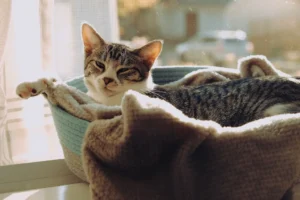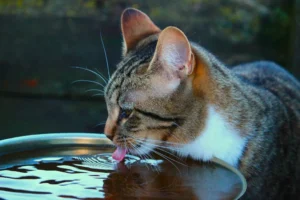Have you noticed your cat’s whiskers looking a bit crinkled lately? Wondering what could be causing this unusual phenomenon? Look no further for answers!
What Causes Crinkled Whiskers in Cats
Have you ever noticed your cat’s whiskers looking a bit crinkled? Well, there are a few reasons why this might be happening. One common cause of crinkled whiskers is rough play or rubbing against rough surfaces. Cats are curious creatures, and they love to explore their surroundings, sometimes resulting in their whiskers getting bent out of shape.
Another possible reason for crinkled whiskers could be poor nutrition or dehydration. Whiskers are made of keratin, the same protein that makes up human hair and nails. So, just like you need a balanced diet to keep your hair healthy, your cat needs proper nutrition to maintain strong and healthy whiskers.
Stress and anxiety can also lead to crinkled whiskers in cats. Stress can cause changes in a cat’s behavior, including excessive grooming or rubbing their face against surfaces, which can result in damaged whiskers. It’s essential to create a calm and comfortable environment for your cat to reduce stress and promote well-being.
If you notice your cat’s whiskers are consistently crinkled, it’s essential to address the underlying cause. Consult with your veterinarian to rule out any medical issues and ensure your cat’s overall health and well-being.
Understanding the Purpose of Whiskers
Whiskers, also known as vibrissae, are not just for show – they serve a crucial role in a cat’s sensory perception and overall well-being. Whiskers are highly sensitive touch receptors that help cats navigate their environment with precision.
These specialized hairs are connected to nerve endings deep within a cat’s skin, providing valuable sensory information about their surroundings. Whiskers help cats detect changes in airflow, navigate in the dark, and even determine if they can fit through tight spaces.
It’s essential not to trim or manipulate a cat’s whiskers, as this can disrupt their sensory perception and cause discomfort. Respect your cat’s whiskers as a vital tool for their well-being and allow them to fulfill their natural purpose without interference.
Remember, crinkled whiskers can indicate underlying issues that need attention, so be sure to monitor your cat’s whiskers closely for any changes and seek professional advice if needed. Your cat’s whiskers are more than just cute adornments – they are essential sensory tools that contribute to their overall health and happiness.
Health Concerns and Whisker Changes
Have you noticed your cat’s whiskers looking crinkled? This could be a sign of an underlying health issue that needs attention. Cats’ whiskers are not just for decoration – they are highly sensitive and play a crucial role in helping your furry friend navigate the world around them. If you see a change in your cat’s whiskers, such as them appearing crinkled or bent, it’s essential to consult with your veterinarian to rule out any health concerns.
Crinkled whiskers could be a sign of a nutritional deficiency, allergies, or even an allergic reaction to something in their environment. It could also indicate a skin condition or infection that requires treatment. Regular grooming and keeping your cat’s environment clean can help prevent these issues. Additionally, stress and anxiety can also manifest in physical changes like crinkled whiskers, so it’s worth considering if there have been any recent changes in your cat’s routine or environment that could be causing them distress.
If you notice your cat’s whiskers are crinkled, don’t panic, but do take it seriously. Schedule a visit to the vet to rule out any health concerns and ensure your feline friend stays happy and healthy. Remember, your cat relies on their whiskers more than you might think, so it’s important to keep an eye on any changes.
Stress and Whisker Behavior
Did you know that stress and anxiety can impact your cat’s whiskers? Cats are sensitive creatures, and changes in their environment or routine can cause them to feel anxious, which can manifest in physical symptoms like crinkled whiskers. If your cat’s whiskers are looking crinkled or bent, it might be a sign that they are experiencing stress.
To help alleviate your cat’s stress and improve their whisker health, try to create a calm and stable environment for them. Provide plenty of hiding spots, vertical spaces for climbing, and interactive toys to keep them engaged and mentally stimulated. Additionally, consider using pheromone diffusers or calming treats to help reduce their anxiety.
Remember, cats are masters at hiding their stress, so it’s essential to be observant of any changes in their behavior or appearance. By addressing the underlying causes of your cat’s stress, you can help improve their whisker health and overall well-being. Your cat will thank you for creating a peaceful and stress-free environment for them to thrive in.
Grooming Habits and Whisker Health
If you’ve noticed your cat’s whiskers looking crinkled, it might be a result of their grooming habits. Cats meticulously groom themselves using their tongues, which can sometimes lead to their whiskers becoming bent or crinkled. To promote healthy whisker growth, consider brushing your cat gently to prevent their whiskers from getting tangled or damaged during grooming. Additionally, providing a balanced diet rich in essential nutrients can contribute to overall whisker health and strength.
Environmental Factors and Whisker Care
The condition of your cat’s whiskers can also be influenced by their surroundings and living conditions. Ensure your cat has enough space to move around freely, as cramped environments can cause stress which may manifest in the form of crinkled whiskers. Keep an eye on any potential irritants in your cat’s environment, such as harsh chemicals or strong odors, as these can also impact the health of their whiskers. Providing a calm and comfortable living space can contribute to maintaining smooth and healthy whiskers for your feline friend.
Whisker Care Tips: 1. Avoid trimming whiskers: Whiskers are essential sensory tools for cats, so refrain from trimming them as it can disrupt their balance and spatial awareness. 2. Regular grooming: Brush your cat gently to prevent tangling and damage to their whiskers. 3. Healthy diet: Ensure your cat is getting a balanced diet to promote overall whisker health. 4. Stress management: Create a peaceful environment for your cat to reduce stress, which can affect their whiskers.
Breed-Specific Whisker Traits
Have you ever noticed that your cat’s whiskers are crinkled and wondered why? Well, it turns out that different cat breeds may have unique whisker characteristics that lead to variations in whisker appearance. For example, some breeds, like the American Curl, have distinctive curled-back whiskers that give them a unique look. These curled whiskers can appear crinkled and add to the cat’s charm.
Another breed, the Cornish Rex, is known for its delicately fine and curly whiskers that can sometimes look crinkled. These unique whisker traits are part of what makes each cat breed special and can contribute to the crinkled appearance of your cat’s whiskers.
So, if you have a cat with crinkled whiskers, it could simply be due to their breed-specific whisker traits. Embrace their individuality and unique look!
Fun Facts About Cats and Whiskers
Did you know that cats’ whiskers are not just for show? These fascinating feline features play a crucial role in helping cats navigate their environment. Each whisker is connected to a sensitive hair follicle and can detect even the slightest changes in their surroundings. This sensory input helps cats judge distances, navigate in the dark, and even communicate with other cats.
Additionally, a cat’s whiskers are roughly as wide as their body, allowing them to determine if they can fit through narrow spaces without getting stuck. These whiskers are not just for decoration; they are essential tools for a cat’s survival and well-being.
Next time you notice your cat’s whiskers looking crinkled, remember that they serve a vital purpose in your feline friend’s daily life. Appreciate the wonder of these whiskers and the remarkable abilities they provide to your cat.
List: – Whiskers can indicate a cat’s mood: When a cat is relaxed, their whiskers are typically held forward. If they are pulled back against their face, it may indicate fear or aggression. – Whiskers shed and regrow: Just like a cat’s fur, whiskers can shed and regrow over time. It’s perfectly normal for whiskers to fall out and be replaced by new ones. – Avoid cutting a cat’s whiskers: Cutting a cat’s whiskers can disorient them and affect their ability to navigate and sense their environment. It’s essential to respect and protect your cat’s whiskers for their well-being.
Remember, your cat’s whiskers are not just a cute feature; they are a vital sensory tool that helps them navigate the world around them. Appreciate and care for these whiskers as much as your cat does.
Alex, a passionate animal lover, has experience in training and understanding animal behavior. As a proud pet parent to two dogs and three cats, he founded AnimalReport.net to share insights from animal experts and expand his knowledge of the animal kingdom.









